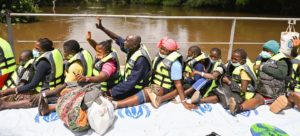As a child, Katsumoto Saotome barely escaped the air raids over Tokyo that killed as many as 100,000 people. He has spent much of his life fighting to honor the memories of others who survived.

In commemoration of the American firebombings of Tokyo, the latest article from “Beyond the World War II We Know,” a series from The Times that documents lesser-known stories from World War II, focuses on Katsumoto Saotome, who has spent much of his life documenting eyewitness accounts from those who survived.
Katsumoto Saotome, 87, came to the door of his home in the outer reaches of Tokyo wearing a herringbone blazer, a black wool scarf tucked neatly into a vest and a black beret that he reckons makes him look like Che Guevara, the guerrilla leader in the Cuban Revolution. Saotome has practiced radicalism of a much quieter kind, insisting on preserving memories that many may prefer to forget.
Seventy-five years ago, less than 10 miles from where he now lives alone in a low-lying neighborhood known for its moderate rents, Saotome (pronounced SAH-oh-toe-meh) survived the brutally effective American firebombing of Tokyo. Over the course of nearly three hours, an attack by the United States Army Air Forces killed as many as 100,000 people — more than some estimates of the number killed the day of the nuclear bombing of Hiroshima. But while the Japanese public — and the world — rightly remember Hiroshima as a living symbol of the horrors of nuclear war, the Tokyo firebombing is generally regarded as a footnote in any accounting of the war in Japan.‘We Hated What We Were Doing’: Veterans Recall Firebombing JapanMarch 9, 2020
There is no public memorial solely dedicated to those who died in the air raid, which started just after midnight on March 10, 1945. Although most casualties of the Tokyo firebombing were civilians, they are not the victims history remembers, in part because Japan itself committed atrocities during the war — and, Saotome and others suspect, because Japan did not want to upset its postwar American occupiers by casting the United States as the aggressor. “I think people do not want to see or know,” said Saotome, who has spent more than five decades collecting and publishing survivors’ accounts and prodding the government to memorialize those who died.
[Sign up for the At War newsletter for more about World War II.]
For 30 years, Saotome tried to secure public funding for a museum to commemorate the Tokyo air raid. In 1990, the city government designated March 10 as Tokyo Peace Day, and it commemorates the anniversary every year, but it never allocated funding for a museum. Undeterred, Saotome raised private donations and opened a modest museum 18 years ago.


Today, the Center of the Tokyo Raid and War Damages sits well outside the city center and is far less known or visited than the Hiroshima peace memorial and museum. In 2018, fewer than 10,000 people, including groups of schoolchildren, visited the Tokyo center, compared with the more than 1.5 million people who visited the Hiroshima memorials the same year.
Saotome said he understood that Hiroshima was unique in that it represented the first time nuclear bombs were used anywhere in the world. “Tokyo was one of many cities where incendiary bombs were dropped,” he said. “It was nothing new or unusual, because they were dropped everywhere.”
The atomic bombings have also had more time to embed themselves in the collective conscience of postwar memories, as survivors began to share their eyewitness accounts very soon after the end of the war. The victims of the Tokyo firebombings, on the other hand, did not tell their stories until long after the war ended. “The people who are from a slightly older generation than me,” he said. “Why were they silent?”
Saotome was just 12 when he and his mother, father and two older sisters scrambled for their lives to escape the incendiary bombs that fell from low-flying B-29s — a U.S. military operation known as Operation Meetinghouse that incinerated nearly 16 square miles of Tokyo 75 years ago. That Saotome was in Tokyo was an accident of birth: Because his birthday fell in the first half of the year, he missed the cutoff for being evacuated with other groups of children sent from the city during the air raids that started the previous summer.


As a child, Saotome spent his days working in an iron factory, collecting scrap metal for munitions. He still keeps the headband he wore to work, which bears the large red circle of the Imperial Japanese rising-sun flag and the Chinese characters for kamikaze, or “divine wind.” Children who worked in the factories were known as Jugo no mamorite, or “defenders behind the guns.” He said American war planners justified the air raids that targeted predominantly residential neighborhoods on the grounds that everyone, even children, was working for the war effort. “We were taught by teachers and on radio programs that Japan would definitely win the war because we were children of the god” — meaning the emperor, Saotome recalled. Even then, he said, he had his doubts, but he kept them to himself. “It was not an era when you could say anything like that,” he said. “If I ever said that I would be disgraced and considered a traitor.”
His family lived in the eastern part of Tokyo known as shitamachi, or “low town,” where poorer families congregated. His mother was a seamstress, and his father, an alcoholic deemed too physically frail to enlist as a soldier, also lived at home. The night of the firebombing, the family had not sought cover in a shelter, made complacent by the almost-daily frequency of the raids. Saotome’s father had been out conducting fire patrols, and when he came home late the night of March 9 to the wooden house they rented, the B-29s were already flying in. This time, his father said, it was impossible to extinguish the fires. The family would need to evacuate.
Shaken awake, Saotome ran to the door. The B-29s were flying so low that when he looked up, he could see the crimson flames from the ground reflected in the silvery metal underbellies of the aircraft. “It almost looked like tropical fish flying above,” he said. As the bombs fell, they released a jellied substance that Saotome later learned was napalm.


The family quickly collected some household items — futon mattresses, kitchen utensils — and loaded them onto a handcart, thinking they might not be able to return to their home for some time. As they began pushing through the streets, they saw how difficult it would be to navigate. Flames were everywhere. Mattresses set on fire rolled down the alleyways. Mothers carried babies on their backs and clung to their older children’s hands, but the blasts from the bombs blew some children away as strong northerly winds fueled the conflagration.
Saotome and his family followed a railroad line toward the Sumida River, stopping at fire buckets placed on street corners to pour water over themselves. By dawn, they could make out the river. Their eyes were crusted with ashes, the tips of the cotton gloves they wore on their hands burned off. Charred bodies were piled on the river banks and in the river.
Many people probably died trying to put out the fires, Saotome said, as the law at the time prohibited civilians from evacuating and required them to fight the flames. In the early morning light, his father dispatched Saotome to check on the family home. He found the route by identifying the factory where he worked and following the streets back from there. The house was still standing, if badly charred. The family returned home, making do among the burned remains.
“For a child who did not know the true meaning of death or fear, March 10 was my first experience of that,” Saotome said. “I have nothing to describe the memory of that night. It is difficult to talk about it, even now.”
It was 25 years later when Saotome, then a novelist, attended a lecture by a well-known history professor. At the end of his talk, Saotome raised his hand. Why, he asked, were there so many references to the Hiroshima and Nagasaki bombings in school textbooks, but nothing about the Tokyo air raid? The professor acknowledged the deficit, but said he had trouble finding any documentation about the event. Saotome decided then that he would take on the task of finding survivors and asking them to share their stories of that terrible night. He recruited 16 other survivors to lobby the governor of Tokyo for help with their effort to record eyewitness accounts and excavate any archival materials. In 1971, he published the accounts of seven survivors, plus his own, modeling his writing after John Hersey’s famous account in The New Yorker of the immediate aftermath of the bombing of Hiroshima. Saotome’s book has sold about 550,000 copies. He went on to publish five more volumes of survivors’ accounts, although only the original book is still in print. After years of futile lobbying for public funding, he sought private donations to open the museum that commemorates the air raid.


The two-story building is a little difficult to find in eastern Tokyo. On the walls are large maps indicating the path of the bombs and aerial photographs that show how the fire razed a large swath of the city. The displays include graphic photographs of charred bodies as well as glass cases containing gas masks, bomb casings, helmets, buttons and letters sent by children who evacuated to the countryside. In one case sits a tiny figure of the three wise see-no-evil-hear-no-evil-speak-no-evil monkeys, blackened by the fires.
Saotome, now retired from his post as director of the museum, said he is not seeking an apology from the United States. He recalls that he once even became friendly with an American B-29 pilot who had visited Japan to identify the spot where he landed in a parachute. But when Saotome tried to show him a film that recreated the night of the bombing, the pilot balked. “Maybe that was too vivid for him,” said Saotome. “It was dark below the airplanes. That footage was so real, and that made him so upset.”
He does, however, hold a grudge against the Japanese government. A group of survivors of the Tokyo air raid sued the Japanese government in 2007, seeking compensation and an acknowledgment of its role in starting the war. “As a Japanese national,” he said, “I think the Japanese government should admit their responsibility.” Japan’s Supreme Court rejected their claim.
Saotome said he also could never forgive his government for awarding Curtis LeMay, the architect of the Tokyo air raid, the First‐Class Order of Merit of the Grand Cordon of the Rising Sun, for helping to establish Japan’s modern air force after the war. “This is totally unacceptable,” he said.
But Saotome is toughest, perhaps, on himself. Despite spending most of his adult life fighting to honor the memories of the Tokyo firebombing survivors, he lamented that the public has not recognized the significance of what was lost or who suffered that night. He is worried that he is running out of time. “I don’t know how many more years I can go on,” he said, while other survivors are passing away. “In order to make people understand, we should have raised our voices much louder,” he said. “We should have tried much harder. But it wasn’t enough.”






